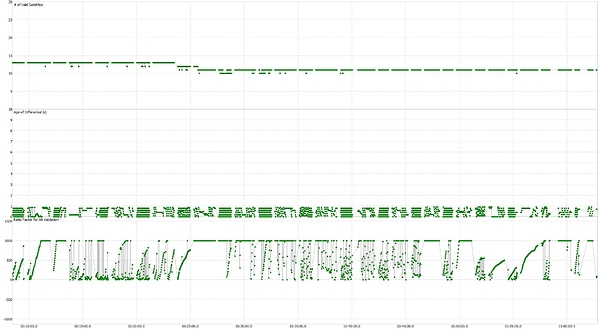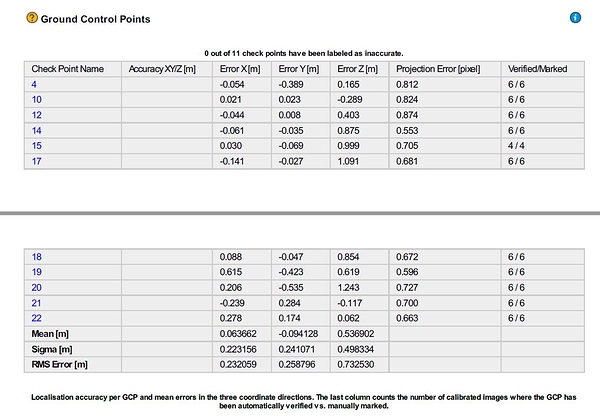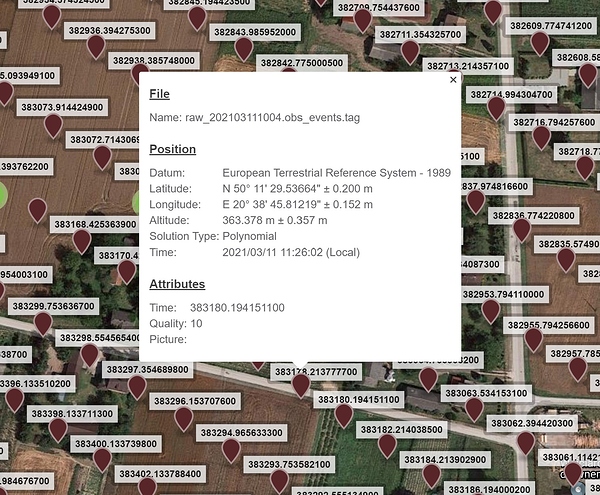Hello everyone,
Recently my company bought M2 Emlid reach set. I have a problem with aerial photography. After post processing RTKPLOT said that 100% points in pos.event file were fixed. Report from pix4d mapper indicated few points with about 20-30 cm error and 2 with about 50 cm error. I think the problem is Ratio Factor for AR Validation. AR Validation graph show decrease of ratio factor for few minutes. What to do to solve this issue? Thanks
RTKPOST settings:
rtkpost_qt options (2021/03/13 11:34:26, v.2.4.3 Emlid b33)
pos1-posmode =kinematic # (0:single,1:dgps,2:kinematic,3:static,4:static-start,5:movingbase,6:fixed,7:ppp-kine,8:ppp-static,9:ppp-fixed)
pos1-frequency =l1+l2 # (1:l1,2:l1+l2,3:l1+l2+l5,4:l1+l5)
pos1-soltype =forward # (0:forward,1:backward,2:combined)
pos1-elmask =20 # (deg)
pos1-snrmask_r =on # (0:off,1:on)
pos1-snrmask_b =off # (0:off,1:on)
pos1-snrmask_L1 =40,40,40,40,40,40,40,40,40
pos1-snrmask_L2 =40,40,40,40,40,40,40,40,40
pos1-snrmask_L5 =4,40,40,40,40,40,40,40,40
pos1-dynamics =on # (0:off,1:on)
pos1-tidecorr =off # (0:off,1:on,2:otl)
pos1-ionoopt =brdc # (0:off,1:brdc,2:sbas,3:dual-freq,4:est-stec,5:ionex-tec,6:qzs-brdc,7:qzs-lex,8:stec)
pos1-tropopt =sbas # (0:off,1:saas,2:sbas,3:est-ztd,4:est-ztdgrad,5:ztd)
pos1-sateph =brdc # (0:brdc,1:precise,2:brdc+sbas,3:brdc+ssrapc,4:brdc+ssrcom)
pos1-posopt1 =off # (0:off,1:on)
pos1-posopt2 =off # (0:off,1:on)
pos1-posopt3 =off # (0:off,1:on,2:precise)
pos1-posopt4 =off # (0:off,1:on)
pos1-posopt5 =off # (0:off,1:on)
pos1-posopt6 =off # (0:off,1:on)
pos1-exclsats = # (prn …)
pos1-navsys =63 # (1:gps+2:sbas+4:glo+8:gal+16:qzs+32:comp)
pos2-armode =fix-and-hold # (0:off,1:continuous,2:instantaneous,3:fix-and-hold)
pos2-gloarmode =on # (0:off,1:on,2:autocal,3:fix-and-hold)
pos2-bdsarmode =on # (0:off,1:on)
pos2-arfilter =on # (0:off,1:on)
pos2-arthres =3
pos2-arthres1 =0.1
pos2-arthres2 =0.25
pos2-arthres3 =0.1
pos2-arthres4 =0.05
pos2-varholdamb =0.001 # (cyc^2)
pos2-gainholdamb =0.01
pos2-arlockcnt =0
pos2-minfixsats =4
pos2-minholdsats =5
pos2-mindropsats =20
pos2-rcvstds =off # (0:off,1:on)
pos2-arelmask =0 # (deg)
pos2-arminfix =100
pos2-armaxiter =1
pos2-elmaskhold =0 # (deg)
pos2-aroutcnt =100
pos2-maxage =60 # (s)
pos2-syncsol =off # (0:off,1:on)
pos2-slipthres =0.05 # (m)
pos2-rejionno =1000 # (m)
pos2-rejgdop =30
pos2-niter =1
pos2-baselen =0 # (m)
pos2-basesig =0 # (m)
smooth-mode =pos-domain # (0:off,1:meas-domain,2:pos-domain)
smooth-window =100 # (s)
smooth-varratio =0.2
base-multi_epoch =on # (0:off,1:on)
resid-mode =on # (0:off,1:on)
resid-maxiter =2
resid-reset_fix =0.3 # (m)
resid-reset_float =1 # (m)
resid-block_fix_sat =0.3 # (m)
out-solformat =llh # (0:llh,1:xyz,2:enu,3:nmea)
out-outhead =on # (0:off,1:on)
out-outopt =off # (0:off,1:on)
out-outvel =off # (0:off,1:on)
out-timesys =gpst # (0:gpst,1:utc,2:jst)
out-timeform =hms # (0:tow,1:hms)
out-timendec =3
out-degform =deg # (0:deg,1:dms)
out-fieldsep =
out-outsingle =on # (0:off,1:on)
out-maxsolstd =0 # (m)
out-height =geodetic # (0:ellipsoidal,1:geodetic)
out-geoid =egm96 # (0:internal,1:egm96,2:egm08_2.5,3:egm08_1,4:gsi2000)
out-solstatic =all # (0:all,1:single)
out-nmeaintv1 =0 # (s)
out-nmeaintv2 =0 # (s)
out-outstat =off # (0:off,1:state,2:residual)
out-addit_info =off # (0:off,1:on)
stats-eratio1 =300
stats-eratio2 =100
stats-errphase =0.003 # (m)
stats-errphaseel =0.003 # (m)
stats-errphasebl =0 # (m/10km)
stats-errdoppler =10 # (Hz)
stats-stdbias =30 # (m)
stats-stdiono =0.03 # (m)
stats-stdtrop =0.3 # (m)
stats-prnaccelh =1 # (m/s^2)
stats-prnaccelv =1 # (m/s^2)
stats-prnbias =0.0001 # (m)
stats-prniono =0.001 # (m)
stats-prntrop =0.0001 # (m)
stats-prnpos =0 # (m)
stats-clkstab =5e-012 # (s/s)
ant1-postype =llh # (0:llh,1:xyz,2:single,3:posfile,4:rinexhead,5:rtcm,6:raw)
ant1-pos1 =0 # (deg|m)
ant1-pos2 =0 # (deg|m)
ant1-pos3 =0 # (m|m)
ant1-anttype =
ant1-antdele =0 # (m)
ant1-antdeln =0 # (m)
ant1-antdelu =0 # (m)
ant2-postype =rinexhead # (0:llh,1:xyz,2:single,3:posfile,4:rinexhead,5:rtcm,6:raw)
ant2-pos1 =0 # (deg|m)
ant2-pos2 =0 # (deg|m)
ant2-pos3 =0 # (m|m)
ant2-anttype =
ant2-antdele =0 # (m)
ant2-antdeln =0 # (m)
ant2-antdelu =0 # (m)
ant2-maxaveep =0
ant2-initrst =off # (0:off,1:on)
misc-timeinterp =off # (0:off,1:on)
misc-sbasatsel =0 # (0:all)
misc-rnxopt1 =
misc-rnxopt2 =
misc-pppopt =
file-satantfile =
file-rcvantfile =
file-staposfile =
file-geoidfile =
file-ionofile =
file-dcbfile =
file-eopfile =
file-blqfile =
file-tempdir =
file-geexefile =
file-solstatfile =
file-tracefile =







